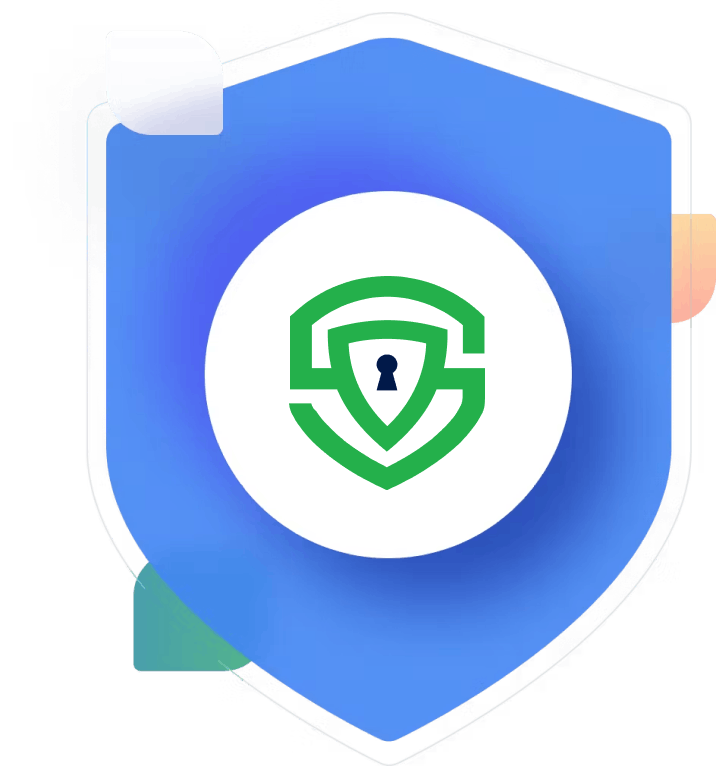The Difference Between Opt-In vs Opt-Out Principles In Data Privacy: What You Need To Know
Understand the key differences between Opt-In and Opt-Out. Learn effective implementation while ensuring compliance with GDPR, CCPA, & LGPD.
What is the difference between opt-in and opt-out in data privacy?
Opt-in and opt-out are approaches to data privacy on which the two main trends in data protection laws are based. They describe internet users’ actions concerning their personal data when accessing a website or an app— such as accepting cookies, requesting to be forgotten, and so on.
This may sound abstract, but let’s break it down so you can better understand the terms ‘opt-in’ and ‘opt-out’ and what these mean for your business.
First, we will explain the differences between the two approaches to data protection. This will help us understand the importance of opt-in and opt-out in your business’s everyday operations.
You need to comply with the data protection laws of the country where your business is located and the data protection laws where your users come from. That’s why most online businesses need to comply with more than one data privacy law — they never know where the next user may come from.
Opt-In
In the world of data privacy, opt-in means the power rests with you. You choose whether or not to share your information with an organization. If you don't actively give the green light, your data is off-limits. This principle applies to a variety of scenarios:
- Cookies: Websites that use cookies to track your behavior or personalize ads must first ask for your permission before setting them. This typically happens through a pop-up banner when you first visit the site.
- Email Marketing: Companies can't bombard your inbox with newsletters unless you've explicitly agreed to receive them. Opt-in ensures you only receive communications you're interested in.
- Analytics: Tools like Google Analytics, which track website traffic, may require your consent depending on your location. If so, you need to take an active step to allow data collection.
This "opt-in first" approach is becoming increasingly common. Regulations like the EU's General Data Protection Regulation (GDPR) and Brazil's LGPD prioritize user control over data, and many other countries are following suit. In contrast, the US currently leans towards opt-out, meaning you have to actively unsubscribe from unwanted communications.
What is an opt-in?
Opt-in is an affirmative action the user takes to allow you to process their personal data. The user opts in when they indicate that they agree to have their data processed by you.
In the case of GDPR, LGPD, Thai PDPA, and similar laws, this mostly comes from cookie consent. The business puts a cookie banner on the website asking for consent, and the user can freely choose whether to opt-in or not.
Clicking an "ACCEPT" button means a successful opt-in. Clicking a "DECLINE" button means that the user does not accept cookies; hence it is neither opt-in nor opt-out.
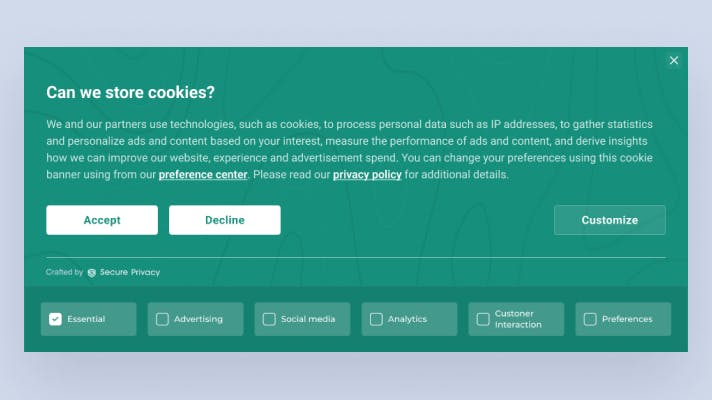
The opt-in also has to be valid. It is valid if it meets the requirements set by the law. In the case of obtaining consent according to the GDPR, it has to be given freely, specific, informed, and unambiguous. Otherwise, it doesn’t count as an opt-in.
Aside from interacting with the cookie banner, users can opt-in in other ways too. Some common opt-in methods include cookie consent banners, checkboxes for receiving emails, opt-in boxes, and others. Sometimes users leave their personal information to have a product delivered to their home; sometimes they want to be contacted by customer support, sometimes, they want to receive a freebie from the business.
There are many ways to opt in, but one thing is always common for all - the business must not use personal data before the opt-in.
When is opt-in mandatory?
Opt-in can be mandatory in various contexts, even outside specific legal requirements. Here are some situations where opt-in is commonly considered mandatory:
- Email Marketing: In many jurisdictions, businesses are required to obtain opt-in consent from users before sending them marketing emails. This ensures that individuals have given their explicit consent to receive any type of message.
- Subscription Services: When signing up for subscription-based services, it is often mandatory for users to actively opt in to the service. This ensures that users are aware of the terms and conditions and willingly choose to subscribe.
- Data Sharing and Third-Party Sharing: If a company intends to share an individual's personal data with third parties, opt-in consent may be required. This ensures that individuals have control and knowledge of how their information will be shared and with whom.
- Sensitive Information: When dealing with sensitive information, such as health records or financial data, opt-in consent is often mandatory. This ensures that individuals have explicitly agreed to the processing and sharing of their sensitive data.
- Research and Surveys: In research studies or surveys, obtaining opt-in consent is considered a best practice to ensure that participants willingly agree to participate and share their information.
- Location-Based Services: When collecting location data from users, businesses often require opt-in consent to ensure that individuals are aware of and agree to the collection and use of their location information.
These examples illustrate common scenarios where opt-in consent is considered mandatory. However, the specific requirements may vary depending on applicable laws and regulations in different jurisdictions.
What are the advantages of opt-in?
By requiring individuals to actively choose to share their information, opt-in offers a multitude of advantages compared to traditional opt-out models.
Opt-in empowers individuals. They have the final say over how their data is used, making informed decisions about what information they share and with whom. This shift in control builds trust and fosters a sense of agency in a landscape where privacy concerns are paramount. Opt-in also demands clear communication. Organizations must explain their data practices, purposes, and potential risks openly and honestly. This transparency fosters trust and allows individuals to make informed choices about whether or not to opt-in.
Opt-in acts as a shield against unwanted data collection. Personal information is only collected and used with explicit consent, minimizing the risk of privacy breaches and unauthorized use. This protection empowers individuals and ensures their data is treated with respect. Opt-in also helps organizations navigate complex data regulations like GDPR. By obtaining explicit consent, they comply with legal requirements and avoid potential fines or penalties. This legal certainty creates a safe and secure environment for both individuals and organizations. Individuals who actively choose to engage are more likely to be receptive to communications and participate in activities. This translates to higher-quality leads, more effective marketing campaigns, and improved customer engagement overall.
Lastly, opt-in aligns with responsible data handling. Organizations collect and use personal data only with explicit permission and for legitimate purposes. This respect for individual autonomy promotes ethical data practices and builds a foundation for a more trustworthy digital ecosystem.
What are the disadvantages of opt-in?
While opt-in empowers individuals and safeguards privacy, it's not without its challenges for organizations.
Opt-in can translate to smaller data pools. Unlike opt-out, where most users are included by default, individuals must actively choose to participate. This can shrink the audience for marketing campaigns, research initiatives, or data analysis. Limited opt-in can also lead to data scarcity, restricting valuable insights. Organizations may lack comprehensive data sets for understanding user behavior, optimizing processes, or making informed decisions. Opt-in data may be inherently biased. Individuals who choose to opt in might have different characteristics or preferences than those who don't. This can skew data sets and lead to inaccurate or misleading insights.
Implementing and maintaining an opt-in system requires strong compliance measures. Capturing, managing, and updating consent preferences can be resource-intensive. Organizations need robust systems to track consent, offer opt-out mechanisms, and comply with regulations like the GDPR's requirement for explicit consent for specific data activities.
Finally, consent mechanisms can add friction to the user experience. Navigating forms, checkboxes, and consent pop-ups can be clunky and time-consuming, potentially leading to user frustration or abandonment.
Opt-Out
The opt-out approach takes a different tack on data privacy. Unlike opt-in, where you actively choose to share your information, opt-out lets your silence speak for itself. Think of it this way:
- Websites: No need for pop-up consent banners before firing cookies. Data collection starts the moment you arrive, unless you specifically tell them otherwise.
- Email Marketing: Companies can send you emails even if you haven't explicitly signed up. It's up to you to unsubscribe if you don't want the messages.
- Analytics: Tools like Google Analytics can track your online footprints without needing your permission beforehand. However, you can usually adjust settings or install browser extensions to opt out later.
This "passive control" approach is currently embraced by a handful of US states, including California (CCPA and CPRA), Colorado (CPA), Virginia (VCDPA), Utah (UCPA), and Connecticut (CTDPA).
What is an opt-out?
Opt-out is the user’s act of indicating that they don’t want their data processed anymore. The opt-out assumes that you process some of their data, and they tell you that they don’t want you to do it in the future.
That may include restriction of processing, withdrawal of previously given consent, deletion of personal data, prevention of sales of personal data, or any other action that prevents the data controller, i.e., the business, from doing anything with the personal data they have collected or processed previously.
Opting out is present in all the data protection laws worldwide, even those that rely on the opt-in principle. Whenever a business processes some personal data, they have to provide the user with opt-out request options. Sometimes businesses rely on legitimate interests, others do direct marketing in compliant ways, and it is allowed to process some personal data without opt-in. However, they have to provide data subjects with an opportunity to submit opt-out requests, such as an unsubscribe link or another method.
When is opt-out acceptable?
Whether opt-out is acceptable depends on several factors, including location, type of data, and context.
Here are some situations where opt-out might be considered acceptable:
- Cookies for essential website functionality: In some regions, cookies used for essential website functions like shopping carts or language preferences might be exempt from opt-in requirements.
- Publicly available information: Data already publicly available, like your name or address in a phone book, can be collected without opt-in in many jurisdictions.
- Legitimate interests: Some organizations may be able to process personal data for legitimate interests (e.g., fraud prevention) without consent, but they must demonstrate a clear justification and balance this with individual privacy rights.
- Limited opt-out impact: In some cases, where opting out only has a minor impact on the individual (e.g., receiving occasional marketing emails), opt-out might be considered acceptable.
Overall, the trend is towards stricter data privacy regulations and a preference for opt-in consent. Opt-out is generally less transparent and user-friendly, and it raises concerns about user control and potential for data misuse.
What are the advantages of opt-out?
Opt-out has advantages in specific contexts that businesses need to consider.
Opt-out is often perceived as a simpler and more convenient option for individuals. By default, individuals are included in a particular activity or service, and they have the choice to opt out if they do not wish to participate. Opt-out also typically results in higher participation rates compared to opt-in. Since individuals are automatically included unless they actively choose to opt out, there is a larger pool of participants or users. This also means that opt-out allows organizations to collect and analyze a more comprehensive dataset.
Opt-out can be more cost and resource-efficient for organizations. With opt-out, organizations don't need to allocate significant resources to seek explicit consent for each individual. Opt-out also allows organizations to deliver services or engage with individuals without any barriers.
What are the disadvantages of opt-out?
Opt-out gets a bad reputation mainly for the lack of explicit consent. Opt-out does not require individuals to provide explicit consent before their data is processed or shared. This can raise concerns about privacy and individuals' control over their personal information. With opt-out, individuals may also receive communications or be included in services without their explicit consent. This may also lead to privacy concerns and lessen trust between individuals and organizations.
Implementing opt-out mechanisms in compliance with applicable regulations can be complex. Organizations must ensure that they provide clear and easy-to-use opt-out options, respect individuals' preferences, and promptly process opt-out requests. Opt-out may also raise ethical concerns regarding the balance between individual rights and organizational interests. It places the burden on individuals to actively opt out if they do not wish to participate, potentially shifting the responsibility from the organization to the individual.
EU's General Data Protection Regulation (GDPR): Opt-in
EU's General Data Protection Regulation (GDPR) explicitly requires opt-in consent for certain types of data processing. This means individuals must actively give their permission before their personal data can be collected, used, or shared. This is a significant shift from opt-out models, where individuals need to take action to prevent their data from being used. Here are some key aspects of opt-in under GDPR:
- Explicit and Informed Consent: Consent must be freely given, specific, informed, and unambiguous. This means individuals must understand what data is being collected, how it will be used, and their rights regarding the data. Simply pre-ticked boxes or unclear language are not sufficient.
- Specific Purposes: Consent must be for specific and clearly defined purposes. Organizations cannot obtain blanket consent for all possible uses of the data.
- Right to Withdraw Consent: Individuals have the right to withdraw their consent at any time and free of charge. Organizations must make it easy for individuals to do so.
- Transparency: Organizations must be transparent about their data processing practices and ensure individuals are aware of their rights. This includes providing a privacy policy with clear and concise information.
- Compliance: Failing to comply with opt-in requirements can lead to significant fines for organizations.
- Impact on Organizations: GDPR's opt-in requirement puts the onus on organizations to obtain valid consent and manage it effectively. This necessitates changes to data collection practices, privacy policies, and internal processes.
Advantages of Opt-In:
- Strengthens user control and privacy: Individuals have clear control over their data and can make informed decisions about its use.
- Builds trust and transparency: Transparent and informed consent fosters trust between organizations and individuals.
- Reduces privacy risks: Opt-in minimizes the risk of unauthorized data collection and use.
- Increases compliance: By adhering to opt-in, organizations reduce the risk of fines and legal issues.
Challenges of Opt-In:
- Potential impact on data collection: Opt-in might lead to lower data collection rates compared to opt-out.
- Increased administrative burden: Managing consent records and requests can be resource-intensive.
- User experience considerations: Implementing opt-in mechanisms should be user-friendly and not overly cumbersome.
Overall, while opt-in presents some challenges, it aligns with GDPR's core principles of individual control, transparency, and accountability. By embracing opt-in, organizations can ensure data privacy compliance and build trust with individuals in the EU and beyond.
California's California Consumer Privacy Act (CCPA): Opt-out
While the EU's GDPR leans heavily on opt-in consent, California's CCPA takes a different approach. Currently, the CCPA operates under an opt-out model for most data collection activities. This means businesses can collect personal information from California residents without their explicit consent, but they must provide a clear and accessible way for them to opt out of the sale of their information to third parties. The CCPA's opt-out model offers certain advantages for businesses. Here's a summary of the CCPA's opt-out approach:
- Right to Opt-Out: California residents have the right to opt out of the sale of their personal information to third parties. Businesses must provide a clear and conspicuous link or mechanism on their website and mobile app for individuals to submit their opt-out request. CCPA 2026 requirements expand this right to include sharing for cross-context behavioral advertising.
- Types of Information Subject to Opt-Out: The right to opt-out applies to personal information as defined by the CCPA, which includes a wide range of data points like names, addresses, email addresses, browsing history, and geolocation data.
- Verification and Revocation: Businesses must verify the identity of individuals submitting opt-out requests and allow them to revoke their opt-out at any time.
- Exceptions: The opt-out requirement doesn't apply to certain types of data sharing, such as sharing with service providers for operational purposes or disclosing information to comply with legal obligations.
- Impact on Businesses: The CCPA's opt-out model requires businesses operating in California to implement mechanisms for individuals to exercise their opt-out rights. This includes displaying clear opt-out links, processing requests promptly, and maintaining records of opt-out choices.
While the opt-out model persists, CCPA 2026 requirements strengthen consumer control mechanisms and transparency obligations.
Advantages of Opt-Out:
- Potentially higher data collection rates: Compared to opt-in, opt-out can lead to more data being collected initially, potentially benefiting businesses relying on data analysis.
- Reduced administrative burden: Implementing opt-out mechanisms might be less resource-intensive than managing opt-in consent records.
- Less disruptive to user experience: Opt-out doesn't require immediate user action during data collection, potentially improving user experience.
Challenges of Opt-Out:
- Limited user control: Individuals may not be aware they are being tracked or have difficulty finding the opt-out mechanism, potentially compromising their privacy.
- Transparency concerns: Opt-out doesn't guarantee transparency about all data practices, potentially raising user concerns about data usage.
- Potential for misuse: Unintentional or malicious actors could exploit the opt-out system to collect and use data without meaningful user knowledge.
- Evolving legal landscape: Opt-out is facing increasing scrutiny in data privacy regulations, and future updates to the CCPA or other laws could change the landscape.
While the CCPA currently operates under opt-out, the California Privacy Rights Act (CPRA), which already took effect in 2023, introduced new opt-in requirements for sensitive personal information like minors' data and precise geolocation data. This means there's a definite shift towards a more opt-in-centric approach in California.
Brazil's General Data Protection Law (LGPD): Opt-in/Opt-out
Brazil's General Data Protection Law (LGPD) takes a hybrid approach to user consent, incorporating elements of both opt-in and opt-out depending on the type of data and processing activity:
Opt-In:
- Required for sensitive data: Processing of sensitive data, such as health information, political opinions, and religious beliefs, requires explicit opt-in consent. Individuals must actively give their permission before this data can be collected or used.
- Applies to specific processing activities: In some cases, even for non-sensitive data, specific processing activities might trigger an opt-in requirement. This includes cross-border data transfers and automated decision-making with significant impact on individuals.
Opt-Out:
- Available for non-sensitive data and certain processing activities: For non-sensitive data and specific processing activities like marketing communications, the LGPD allows for an opt-out approach. This means organizations can collect and process data without explicit consent, but individuals must have a readily available and easily identifiable way to opt out of such processing.
Regardless of the opt-in/opt-out approach, consent must be free, informed, and unambiguous. Individuals must understand what data is being collected, how it will be used, and their rights regarding it. Organizations must be transparent about their data processing practices and clearly inform individuals about their opt-in/opt-out options. Individuals have the right to withdraw their consent at any time, regardless of whether it was opt-in or opt-out.
The LGPD's opt-in requirement for sensitive data aligns with the GDPR's principles of strong user control and informed consent. Unlike the CCPA's primarily opt-out approach, the LGPD mandates opt-in for sensitive data and specific processing activities, offering greater privacy protections.
The LGPD's hybrid approach to opt-in/opt-out balances user control and organizational flexibility. It aims to protect sensitive data with strong opt-in requirements while allowing for efficient processing of non-sensitive data with opt-out options. Organizations operating in Brazil must carefully navigate these requirements and ensure compliance to avoid potential penalties.
Email marketing and opt-in/opt-out
In email marketing, the choice between opt-in and opt-out significantly impacts both your legal compliance and marketing effectiveness. Understanding the nuances of each approach is key to navigating regulations, respecting user preferences, and ultimately maximizing engagement.
Opt-in:
- User control: It all starts with user empowerment. Opt-in requires individuals to actively choose to receive your emails, giving them clear control over their inbox. This fosters trust and transparency, leading to a more engaged audience.
- Higher engagement: People who opt-in are inherently more interested in your content, resulting in higher open rates, click-through rates, and conversions. By focusing on building genuine interest, you avoid spam complaints and nurture valuable relationships.
- Legal compliance: Opt-in aligns with data privacy regulations like GDPR, CCPA/CPRA, and LGPD. Ensuring explicit consent protects you from legal repercussions and ensures ethical data practices.
Opt-out:
- Convenience: Opt-out offers an easy way for users to unsubscribe if they lose interest. Providing a clear and accessible opt-out option demonstrates respect for their preferences and prevents frustration.
- List hygiene: Removing unengaged subscribers regularly keeps your mailing list healthy, improving email deliverability and campaign performance. By letting go of uninterested recipients, you focus resources on those who truly value your communications.
- Potential risks: While convenient, opt-out can lead to lower engagement and higher unsubscribe rates. Hidden or difficult-to-find opt-out mechanisms can damage user trust and harm your reputation.
The ideal approach may blend both opt-in and opt-out elements. Always prioritize opt-in and clearly communicate the value proposition of your emails and provide multiple, easy-to-understand opt-in options. Make opt-out accessible and don't bury the unsubscribe link. Include it in every email footer and offer alternative methods like a "manage preferences" option. Lastly, monitor unsubscribe rates and campaign performance to understand user preferences and refine your strategies.
How can businesses choose the right approach for their data privacy needs?
Choosing the right approach hinges on a nuanced understanding of regulations, user experience, and ethical considerations. While opt-in strengthens user control and aligns with evolving privacy laws like GDPR, it can impact data collection rates. Opt-out, favored by CCPA, offers convenience but raises transparency concerns and might face legal scrutiny.
Ultimately, businesses should prioritize robust consent mechanisms, clear communication, and respect for user choices. Balancing these factors within the specific regulatory landscape and considering the type of data and intended use will help businesses navigate the evolving data privacy landscape responsibly.
Is there any way to combine opt-in and opt-out effectively?
Yes, there are ways to combine opt-in and opt-out effectively to achieve a balance between user privacy and business needs. Here are a few strategies:
Tiered approach: Implement opt-in for sensitive data or high-risk processing activities, while using opt-out for less sensitive data or essential functionalities. This ensures user control over critical information while streamlining collection for basic operations.
Progressive disclosure: Gradually present opt-in choices throughout the user journey, allowing users to make informed decisions about data sharing at different stages. This can improve transparency and user experience compared to a single upfront opt-in form.
Hybrid models: Offer both opt-in and opt-out options for the same data point, providing flexibility for users with different preferences. This caters to diverse user comfort levels and can potentially increase opt-in rates for those who actively choose to share data.
By thoughtfully combining opt-in and opt-out with clear communication and user control, businesses can navigate the data privacy landscape responsibly, respecting user rights while meeting their own operational needs. Remember, the goal is to find a balance that fosters trust and transparency, building a foundation for ethical data practices in the digital age.
How your business get users to opt-in
Getting users to opt-in depends on your situation, but that will be through asking for consent in most cases.
GDPR strictly prescribes how to obtain users’ consent for data processing. According to its legal requirements, opting in must always be an informed decision. You can read in length about that here.
Opting-in for minors under the CCPA requires opting-in by the parent or guardian. In many cases, you may need to confirm the parent or guardian’s presence by talking to them over a toll-free phone or video call for valid compliance.
What should you do when a user opts out?
When a user indicates they want to opt-out, you must fulfill their request, no questions asked. When you receive a request that means opting out, you need to do any of the following:
GDPR and LGPD only
Withdraw consent. Consent withdrawal has to be made as easy as giving consent. Once a user withdraws consent, you must not process their data anymore.
Object or restrict the processing. It depends on the request. The user decides how to object to or restrict the processing. You need to comply with their request, so you need to adjust your data processing as per their request.
CCPA/CPRA only
Opt out of sales or financial incentives, or targeted advertising. US laws allow the sale of personal information. Still, CCPA empowers California residents with the right to opt out of the sale of their personal data by a business that has it.
In the US, it is common for companies to sell personal data. This includes companies that handle sensitive personal information, such as data related to the use of credit cards, financial data, health data, purchase behavior, and so on.
Users can also opt out of any financial incentives program in relation to their personal information. If you receive such a request, you must remove the user’s data from the program records.
GDPR, CCPA/CPRA and LGPD
Delete personal data. Both laws prescribe that when a user requests deletion of their data, you need to remove their personal information from your records.
Opt-in/opt-out with Secure Privacy
GDPR is the synonym for the opt-in principle, and the CCPA is the synonym for the opt-out approach. However, it is not all black and white. They both prescribe in what cases you must rely on the user’s opt-in to the processing and when you can just wait for them to opt out. That’s why you need to learn how to act in every situation.
If you don’t want to bother with that, Secure Privacy’s consent management solution ensures effortless compliance with users’ opting in and out. You don’t have to think about asking for consent or how to delete personal data. It is all embedded in the software. Secure Privacy revolutionizes the way you manage user consent and data security.
- Trusted by leading brands: From e-commerce giants to entertainment powerhouses, Secure Privacy empowers companies across industries to put user control at the forefront. Millions of happy users can't be wrong!
- Effortless to implement, intuitive to manage: Our platform requires minimal technical know-how, leaving you free to focus on what matters – your business.
- Grow with confidence, adapt with ease: Secure Privacy scales alongside your needs, evolving with your data volumes and adapting to new regulations effortlessly.
- Google-certified peace of mind: Our fully certified consent management platform guarantees compliance with the latest regulations, including Google's own standards. No more sleepless nights over opt-in complexity.
Visit Secure Privacy today and schedule a call. Discover how you can transform user consent from a hassle to a competitive advantage.
Get Started For Free with the
#1 Cookie Consent Platform.
No credit card required
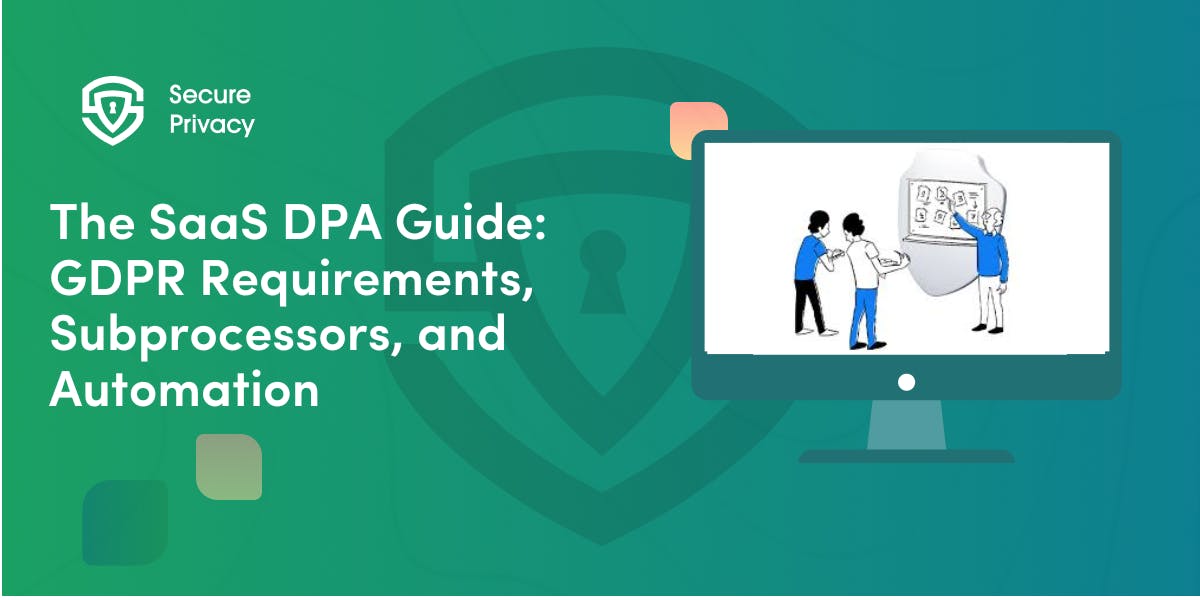
The SaaS DPA Guide: GDPR Requirements, Subprocessors, and Automation
Your enterprise deal stalled in legal review for three weeks while procurement demands a comprehensive data processing agreement, your legal team scrambles to understand GDPR requirements, and your sales team watches the quarter-end deadline approach with increasing anxiety.
- Legal & News
- Data Protection
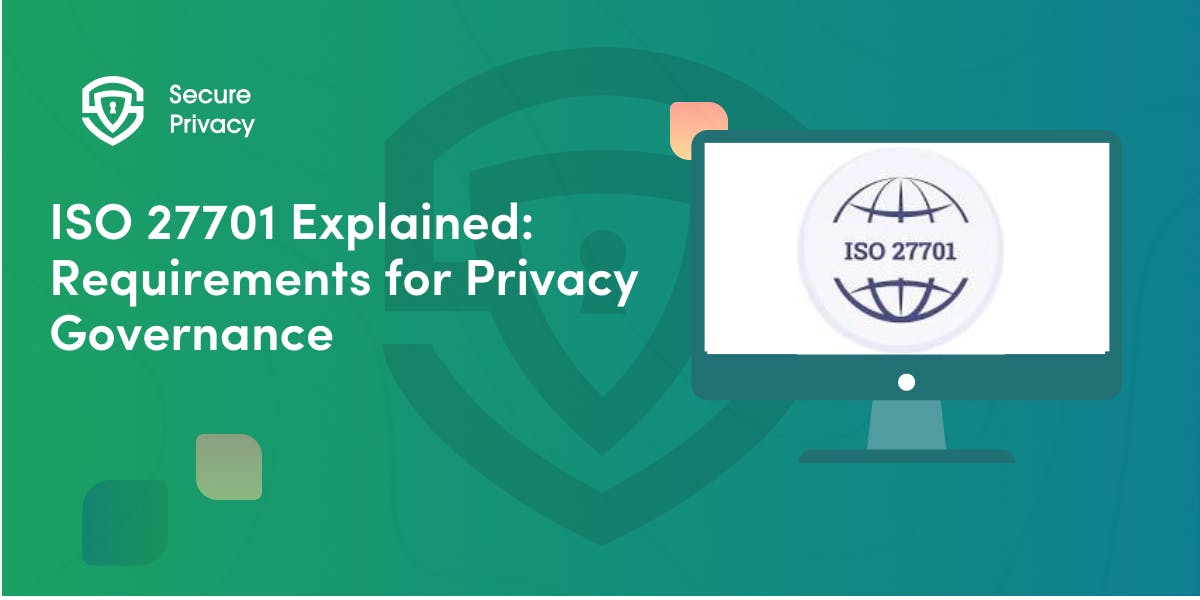
ISO 27701 Explained: Requirements for Privacy Governance
Privacy teams face mounting pressure. Regulators demand proof of systematic data protection. Customers expect transparency. Board members want assurance that privacy risks won't derail operations.
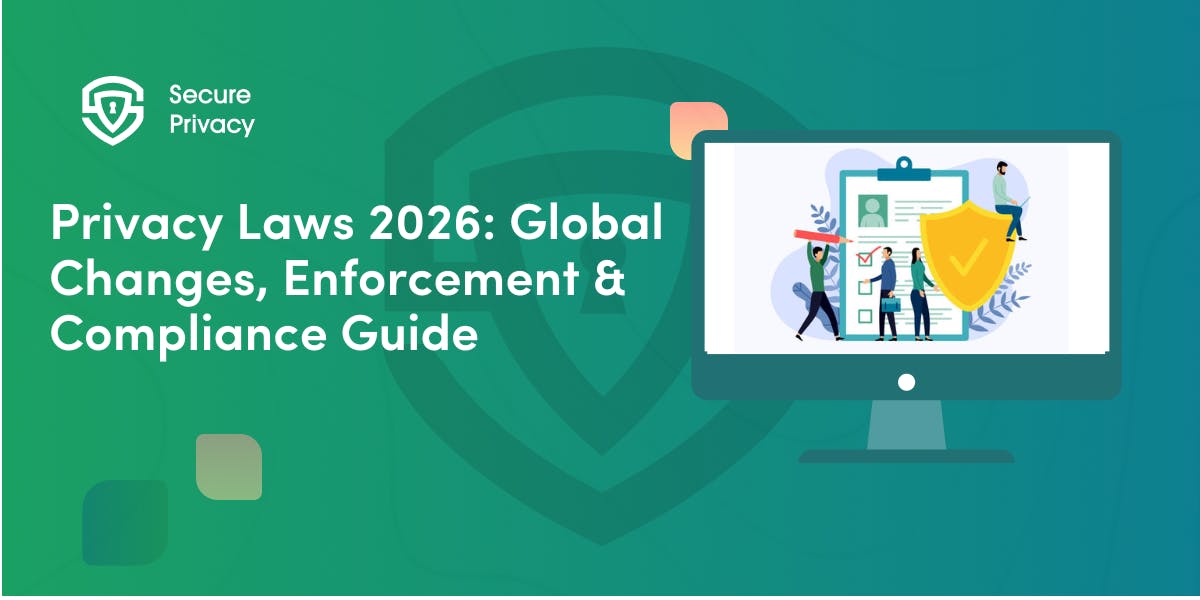
Privacy Laws 2026: Global Changes, Enforcement & Compliance Guide
Privacy regulations multiply faster than compliance teams can track them. Three new U.S. state laws take effect. The EU AI Act reaches full enforcement. India's DPDP Act enters its critical phase.

